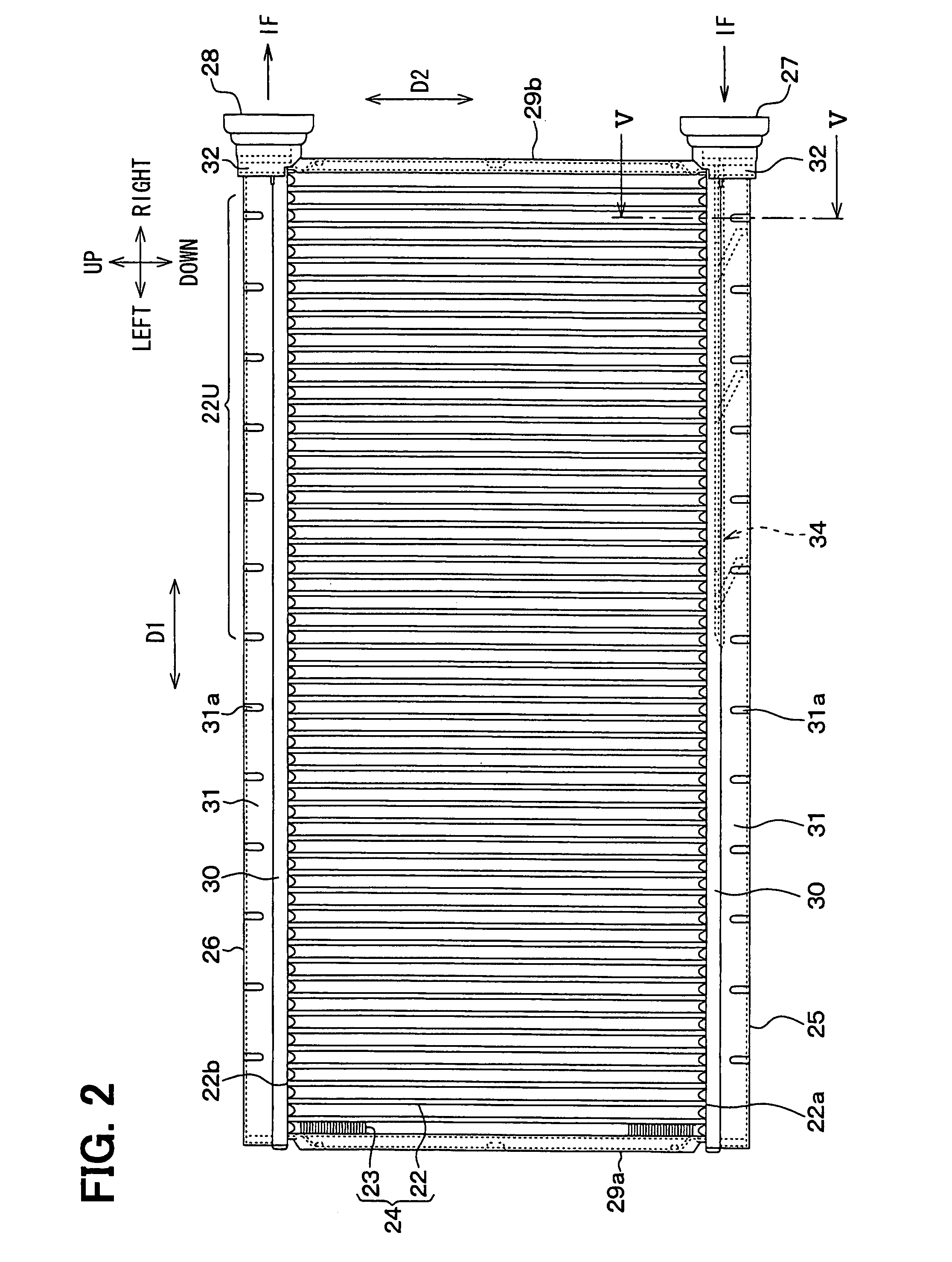Heat exchanger
a heat exchanger and heat exchanger technology, applied in indirect heat exchangers, lighting and heating apparatus, stationary conduit assemblies, etc., can solve the problems of deterioration of air conditioning feeling, uneven volume of internal fluid, complex structure of inlet tanks, etc., to reduce the volume of internal fluid flowing into the remaining tubes is increased, and the volume of internal fluid flowing into the tubes that are closer to the inlet port
- Summary
- Abstract
- Description
- Claims
- Application Information
AI Technical Summary
Benefits of technology
Problems solved by technology
Method used
Image
Examples
first embodiment
[0042]A first embodiment of the present invention will now be described with reference to FIGS. 1 to 14. FIG. 1 shows an air conditioning unit 10 for a vehicular air conditioning apparatus. In the first embodiment, a heat exchanger is employed as a heating heat exchanger (heater core) 13 of the air conditioning unit 10, for example. In the drawings, an up and down arrow, a front and rear arrow and a left and right arrow denote respective directions when the air conditioning unit 10 is mounted on a vehicle.
[0043]The air conditioning apparatus is mounted in a space defined by an instrument panel at a front part of a passenger compartment of a vehicle. Although not illustrated, the air conditioning apparatus has a blower unit for supplying a flow of air toward the air conditioning unit 10. The air conditioning apparatus is for example arranged in a semi-center layout in the space so that the air conditioning unit 10 is mounted in a substantially middle position with respect to a vehicl...
second embodiment
[0109]A second embodiment will be described with reference to FIGS. 15 to 17. In this embodiment, the plate member 34 is preliminarily fixed to the tank main body 31 before the heater core 13 is integrally brazed.
[0110]As shown in FIG. 15, the plate member 34 is formed by shaping a metal plate such as aluminum plate. The plate member 34 has a main wall 40 and leg portions 41 for fixing the main wall 40 to the tank main body 31. The main wall 40 has a generally plate shape and extends in the tube stacking direction D1 with a predetermined width. The wall surface 34a is provided by a first surface of the main wall 40, which faces the inlet ends 22a of the tubes 22U.
[0111]As shown in FIG. 16, the main wall 40 has a tapered shape such that the width thereof reduces from its first end (left end in FIG. 16) that is adjacent to the inlet port 27 toward its second end (right end in FIG. 16) that is farther away than the first end with respect to the inlet port 27. In this embodiment, the ma...
third embodiment
[0120]A third embodiment will be described with reference to FIGS. 18A and 18B. In the third embodiment, the heater core 13 does not have the plate member 34. In place of the plate member 34, the core plate 30 is formed with embossed portions 42 as the cover member.
[0121]The embossed portions 42 project from peripheral portions of the tubes insertion holes 30a, which have burring shapes, toward the inside of the inlet tank 25. Each of the embossed portions 42 has a shape along the inlet end 22a of the tube 22U, which projects inside of the inlet tank 25. The embossed portion 42 partly overlaps the tube insertion hole 30a, as shown in FIG. 18B.
[0122]As such, the opening of the inlet end 22a of each tube 22U is partly covered by the embossed portion 42. Accordingly, similar to the first embodiment, the volume of the internal fluid in each tube 22 is uniform and the difference of the discharge air temperatures in the tube stacking direction D1 is reduced.
[0123]The embossed portions 42 ...
PUM
 Login to View More
Login to View More Abstract
Description
Claims
Application Information
 Login to View More
Login to View More - R&D
- Intellectual Property
- Life Sciences
- Materials
- Tech Scout
- Unparalleled Data Quality
- Higher Quality Content
- 60% Fewer Hallucinations
Browse by: Latest US Patents, China's latest patents, Technical Efficacy Thesaurus, Application Domain, Technology Topic, Popular Technical Reports.
© 2025 PatSnap. All rights reserved.Legal|Privacy policy|Modern Slavery Act Transparency Statement|Sitemap|About US| Contact US: help@patsnap.com



